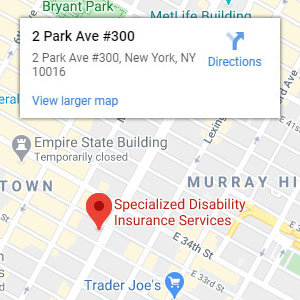As a physician, you have invested substantial time and money to be in a residency program. This puts a lot of pressure on your future income and many of your financial goals depend on your ability to work.
If at any point in your career, if you were out of work or unable to continue in your specialty as a result of an injury or illness, how much would that loss of income impact you? Almost half of all Americans would not be able to cover their bills if they did not receive their monthly income, and over 90% of physicians protect their income with disability insurance. While physicians never plan on or hope to use their disability coverage, they know having coverage can help avoid a financial disaster. Clearly, physicians see the value and desire to protect themselves with disability insurance, but is it worthwhile to obtain coverage during residency?
Some residents may feel they are young and will not become disabled, that they can't afford it, that their hospital provides coverage, or have questions about how much coverage they need, or think they should wait until they are working in their specialty.
Contact Specialized Disability Insurance Services for a free consultation.

8 Reasons to Obtain Disability Insurance During Residency
Discounted Rates
During residency, you can qualify for discounts with most of the top rated carriers. These discounts can result in a 10-30% reduction in the cost of the policy. The benefit is the discount remains after you graduate and with most carriers, you can also apply the discount when you increase coverage after residency/fellowship ends.
Take Advantage of Starter Packages
Disability insurance carriers generally allow you to protect about 60% of your income. Insurance carriers have starter packages, also known as beginning professional limit programs, that allow certain occupations to lock in coverage amounts that exceed their current income. As a resident or fellow, you can lock in up to a $5,000 monthly benefit. This benefit is not taxable, so it is more coverage than a resident or fellow would qualify for based on income. There are also starter packages that apply for medical students and higher limits for soon-to-be and recent graduates of a residency/fellowship program. It is most beneficial to max out coverage up to these starter limits, while they are available. Often this is more coverage than a physician qualifies for on their own.
Rates Are Based on Your Age
The younger you are when you get coverage, the less you pay. Since rates are based on age, it is strategic to get coverage established as early as possible. If you’re in your 20’s or 30’s the rates might not change much from year to year, but slight annual changes turn into large changes over a 3-5 year period. That is why it is best to lock in as early as you can. Delaying the purchase of disability insurance until you are an attending, causes rates to be significantly more than earlier on in your residency, which often results in selecting less or inferior benefits.
Disability Can Happen
While it may seem premature, having coverage can help provide you with options in the event you suffer a disabling event. Take a moment to watch this video and learn about a fellow physicians journey:
Own Occupation Clause
When you get a policy with an own occupation definition, as offered by carriers such as, Ameritas, Guardian, Mass Mutual, Ohio National, Principal, and Standard, you’ll still be properly covered even if you change specialties. This makes getting coverage during residency or your intern year very beneficial. Prior to declaring your specialty, you could lock in a rate that’s 10-20% less and you can have benefits locked in that you may not qualify for if you applied once you became a surgeon, anesthesiologist or emergency medicine physician. You will not have to get a new policy or redo it if you change specialties or subspecialize.
Lock in Your Good Health
The younger you are when you get coverage, the less you pay. Since rates are based on age, it is strategic to get coverage established as early as possible. If you’re in your 20’s or 30’s the rates might not change much from year to year, but slight annual changes turn into large changes over a 3-5 year period. That is why it is best to lock in as early as you can. Delaying the purchase of disability insurance until you are an attending, causes rates to be significantly more than earlier on in your residency, which often results in selecting less or inferior benefits.
-
A PGY 4, that happened to be a former college football player, had gained about 25 lbs during his residency. While he had a strong build at 5’10, 240lbs, his weight gain resulted in him paying a 25% increase for his policy.
-
A right-handed dermatologist received a policy with a right-hand exclusion. This exclusion resulted from a fracture while on a post-residency adventure trip.
-
A female GI consulted a cardiologist since she believed she was experiencing palpitations. While the cardiologist assured her, she was fine, she was suggested to complete follow up treatment was diagnosed with VT. This caused her coverage to be adversely affected and extremely limited.
- An anesthesiologist in his third year was told by his fiancé his snoring was unbearable. As a result, he went for a sleep study and was diagnosed with sleep apnea. The diagnosis resulted in a limited policy with high rates.
Ability to Increase Benefits in the Future
Applicants in “good” health can include provisions that allow them to increase their disability benefit in the future, without having to pass new medical assessments. This means you lock in coverage now and any future conditions that come up will not impact current or additional coverage. With some carriers, such as Principal, Guardian, and Standard, this benefit can be added to a policy at no additional cost. With Principal, during your residency or fellowship, you can purchase a top-quality policy for $25-50/month (rates vary based on age, gender, and specialty) that can lock in your ability to increase up to a $30,000 monthly benefit in the future.
Quick and Easy Process
During residency and/or fellowship the insurance carriers can waive some of the requirements typically associated with obtaining coverage. If you apply while in residency and fellowship you will not have to submit tax returns or complete a medical exam to qualify for coverage. This saves a lot of time and makes obtaining coverage during residency super easy!
Get a personalized disability insurance policy designed to ensure you get paid if you can't work due to injury or illness.
How Much Coverage Can You Get?
Insurance carriers have special starter programs designed for residents and fellows. Take advantage, these programs can be better than other options in the future.
- Resident & Fellows can get a $5,000 monthly benefit
- Graduating resident & fellows can get up to a $7,500 monthly benefit
- These Starter packages can lock in your health and allow you to increase up to a $20,000 monthly benefit, without any future medical underwriting
- We can help design coverage to lock in your health for up to a $30,000 monthly benefit, without any future medical underwriting.
Frequently Asked Questions About Disability Insurance for Medical Residents and Fellows
The elimination period is the amount of time from the date you became disabled and the date that your disability payments begin. This period is usually set between 3 to 12 months. Group policies often have the length of the elimination period included in the terms of the policy. In individual disability policies, the policyholder chooses the desired length of the elimination period.
The elimination period is not unlike the deductible in an auto or health insurance policy. It’s the amount of loss coverage that you opt to self-insure prior to policy benefits taking effect. So, with disability insurance (DI), naturally, the shorter the elimination period selected, the more expensive the policy.
It is always preferable to have a disability policy prior to becoming disabled! Additionally, of course, the younger and healthier you are at the time you start your policy, the cheaper the premium rate you can lock in for the rest of your career. Another important consideration is the possibility of having a medical condition that predisposes a person to a disability, though the individual is not yet disabled.
Waiting until later could leave you unable to purchase physician disability insurance at all (or life insurance). Or, you could find it only possible to buy a disability policy that excludes the disability that can potentially develop from your pre-existing condition. So, the most practical possible time to obtain your disability policy is during your fellowship training or residency, before starting your first real employment as a doctor, while you are younger and healthier than you’ll ever be again in your life.
The “future increase” (also called the “future purchase”) option permits you to increase the amount of your disability insurance benefits in the future. So, whenever you are making a larger income, you can protect it with a commensurate amount of disability insurance, for an increased premium payment amount at that time. Generally speaking, the future increase options provided under this rider do not require new underwriting based on updated medical information.
In other words, you can raise your coverage amount despite any health problems you might have developed after you bought your base disability policy. So, essentially, you are paying to reserve the right, under the contract, to add more insurance in the future, when you need a higher amount, regardless of your health condition when you want to add more coverage.
In addition to the future increase option, there are various other additions you can make to your policy through the years, such as these:
| Automatic benefit increase | Some disability policies feature this automatic increase in the basic policy or offer it as an allowed rider. It permits you to make small increases in your benefit amount each year, for a specified number of years, with no need to prove your income has changed. Normally, policyholders also do not have to provide updated information for renewed medical underwriting. The maximum benefit increase that builds over the years through this rider is less than you can accomplish through a "future increase” rider. |
| Cost of living adjustment/increase (COLA) | When a disability insurance policyholder becomes disabled, the monthly benefit payout from most policies is fixed at an amount that will stay the same through the end of the policy at age 65. COLA is a rider that permits you to purchase inflation adjustments in advance. For example, perhaps you can buy an adjustment for 3% inflation each year, or for a range of 0 to 3%, or 0 to 5%, depending on indicators from the relevant inflation metric. |
Schedule a Free Consultation With Specialized Disability Insurance Services
Do you think it is advantageous to obtain disability insurance during residency? If you found this post helpful, please share it with your friends and find the time to arrange a call with a disability insurance specialist to learn more.
